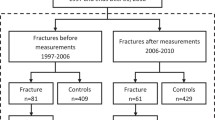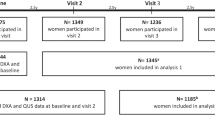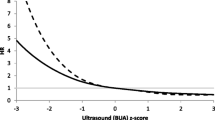Abstract
Summary
Quantitative ultrasound (QUS) is associated with fracture risk in women, but there are few data in men. We studied 5,607 older men and found that QUS predicts hip and any non-spine fracture risk nearly as well as BMD. Combined measurements of QUS and BMD are not superior to either measurement alone.
Introduction
Quantitative ultrasound (QUS) predicts fracture risk among older women, but there are few prospective studies among older men. We studied the ability of QUS and BMD measurements to predict hip and other non-spine fractures in a population-based study of older men.
Methods
Calcaneal QUS and hip BMD were measured in 5,607 men aged ≥65 years recruited from six US centers. At baseline duplicate QUS measurements with repositioning were obtained, and subsequent hip and other non-spine fractures were documented by review of x-rays or x-ray reports. The relationships between QUS and fractures were examined with proportional hazard models adjusted for age and clinic. We used receiver operating characteristic curves and predicted fracture risk models to determine the utility of QUS alone, BMD alone or the combination of QUS+BMD.
Results
During a mean follow-up of 4.2 years with 99% complete follow-up, 239 men suffered a non-spine fracture, including 49 hip fractures. Each standard deviation reduction in broadband ultrasonic attenuation (BUA) was associated with an increased risk of hip (relative hazard=2.0, CI: 1.5, 2.8) and any non-spine fracture (relative hazard=1.6, CI: 1.4, 1.8). The area under the receiver operating characteristic curve and the predicted probability of fracture were similar for BUA alone, BMD alone and the combination of BUA+BMD, indicating that once BUA or BMD is known, the other measurement does not add useful information. Other QUS parameters gave similar results.
Conclusions
QUS measurements predict the risk of hip and any non-spine fracture in older men, and do so nearly as well as hip BMD measurements. Combined measurements of QUS and BMD are not superior to either measurement alone.


Similar content being viewed by others
References
Hans D, Dargent-Molina P, Schott AM, Sebert JL, Cormier C, Kotzki PO et al (1996) Ultrasonographic heel measurements to predict hip fracture in elderly women: the EPIDOS prospective study. Lancet 348:511–514
Huopio J, Kroger H, Honkanen R, Jurvelin J, Saarikoski S, Alhava E (2004) Calcaneal ultrasound predicts early postmenopausal fractures as well as axial BMD. A prospective study of 422 women. Osteoporos Int 15(3):190–195
Bauer DC, Gluer CC, Cauley JA, Vogt TM, Ensrud KE, Genant HK et al (1997) Broadband ultrasound attenuation predicts fractures strongly and independently of densitometry in older women. A prospective study. Study of Osteoporotic Fractures Research Group. Arch Intern Med 157(6):629–634
Nguyen TV, Center JR, Eisman JA (2004) Bone mineral density-independent association of quantitative ultrasound measurements and fracture risk in women. Osteoporos Int 15(12):942–947
Hans D, Schott AM, Arlot ME, Sornay E, Delmas PD, Meunier PJ (1995) Influence of anthropometric parameters on ultrasound measurements of os calcis. Osteoporos Int 5:371–376
Hans D, Arlot ME, Schott AM, Roux JP, Kotzki PO, Meunier PJ (1995) Do ultrasound measurements on the os calcis reflect more the microarchitecture than the bone mass?: a two-dimensional histomorphometric study. Bone 16(3):295–300
Cortet B, Boutry N, Dubois P, Legroux-Gerot I, Cotten A, Marchandise X (2004) Does quantitative ultrasound of bone reflect more bone mineral density than bone microarchitecture? Calcif Tissue Int 74(1):60–67
Laugier P, Giat P, Berger G (1994) Broadband ultrasonic attenuation imaging: a new imaging technique of os calcis. Calcif Tissue Int 54(2):83–86
Wuster C, Hadji P (2001) Use of quantitative ultrasound densitometry (QUS) in male osteoporosis. Calcif Tissue Int 69(4):225–228
Blank JB, Cawthon PM, Carrion-Petersen ML, Harper L, Johnson JP, Mitson E et al (2005) Overview of recruitment for the osteoporotic fractures in men study (MrOS). Contemp Clin Trials 26(5):557–568
Orwoll E, Blank JB, Barrett-Connor E, Cauley J, Cummings S, Ensrud K et al (2005) Design and baseline characteristics of the osteoporotic fractures in men (MrOS) study–a large observational study of the determinants of fracture in older men. Contemp Clin Trials 26(5):569–585
Chen Z, Kooperberg C, Pettinger MB, Bassford T, Cauley JA, LaCroix AZ et al (2004) Validity of self-report for fractures among a multiethnic cohort of postmenopausal women: results from the Women’s Health Initiative observational study and clinical trials. Menopause 11(3):264–274
Looker AC, Wahner HW, Dunn WL, Calvo MS, Harris TB, Heyse SP et al (1995) Proximal femur bone mineral levels of US adults. Osteoporos Int 5(5):389–409
Efron B, Tibshirani R (1993) An introduction to the bootstrap. Chapman & Hall, New York
Hui S, Slemenda C, Carey M, Johnston C (1996) Choosing between predicors of fractures. J Bone Min Res 10(11):1816–1822
McNeil BJ, Hanley JA (1984) Statistical approaches to the analysis of receiver operating characteristic (ROC) curves. Med Decis Making 4(2):137–150
Faulkner KG, von Stetten E, Miller P (1999) Discordance in patient classification using T-scores. J Clin Densitom 2(3):343–350
Orwoll ES, Ettinger M, Weiss S, Miller P et al (2000) Alendronate for the treatment of osteoporosis in men. N Engl J Med 343:604–610
Orwoll ES, Scheele WH, Paul S, Adami S, Syversen U, Diez-Perez A et al (2003) The effect of teriparatide [human parathyroid hormone (1–34)] therapy on bone density in men with osteoporosis. J Bone Miner Res 18(1):9–17
Finkelstein JS, Hayes A, Hunzelman JL, Wyland JJ, Lee H, Neer RM (2003) The effects of parathyroid hormone, alendronate, or both in men with osteoporosis. N Engl J Med 349(13):1216–1226
Pluijm SM, Graafmans WC, Bouter LM, Lips P (1999) Ultrasound measurements for the prediction of osteoporotic fractures in elderly people. Osteoporos Int 9(6):550–556
Varenna M, Sinigaglia L, Adami S, Giannini S, Isaia G, Maggi S et al (2005) Association of quantitative heel ultrasound with history of osteoporotic fractures in elderly men: The ESOPO study. Osteoporos Int 16(12):1749–1754
Gonnelli S, Cepollaro C, Gennari L, Montagnani A, Caffarelli C, Merlotti D et al (2005) Quantitative ultrasound and dual-energy X-ray absorptiometry in the prediction of fragility fracture in men. Osteoporos Int 16(8):963–968
Khaw KT, Reeve J, Luben R, Bingham S, Welch A, Wareham N et al (2004) Prediction of total and hip fracture risk in men and women by quantitative ultrasound of the calcaneus: EPIC-Norfolk prospective population study. Lancet 363(9404):197–202
Fujiwara S, Sone T, Yamazaki K, Yoshimura N, Nakatsuka K, Masunari N et al (2005) Heel bone ultrasound predicts non-spine fracture in Japanese men and women. Osteoporos Int 16(12):2107–2112
Hans D, Hartl F, Krieg MA (2003) Device-specific weighted T-score for two quantitative ultrasounds: operational propositions for the management of osteoporosis for 65 years and older women in Switzerland. Osteoporos Int 14(3):251–258
Conflict of interest statement
None of the authors have any conflict of interest.
Author information
Authors and Affiliations
Consortia
Corresponding author
Additional information
Funding: The Osteoporotic Fractures in Men (MrOS) Study is supported by National Institutes of Health funding. The following institutes provide support: the National Institute of Arthritis and Musculoskeletal and Skin Diseases (NIAMS), the National Institute on Aging (NIA), and the National Cancer Institute (NCI), under the following grant numbers: UO1 AG18197-02, UO1 AR45580-02, UO1 AR45614, UO1 AR45632, UO1 AR45647, UO1 AR45654, UO1 AR45583 and M01 RR00334.
Rights and permissions
About this article
Cite this article
Bauer, D.C., Ewing, S.K., Cauley, J.A. et al. Quantitative ultrasound predicts hip and non-spine fracture in men: the MrOS study. Osteoporos Int 18, 771–777 (2007). https://doi.org/10.1007/s00198-006-0317-5
Received:
Accepted:
Published:
Issue Date:
DOI: https://doi.org/10.1007/s00198-006-0317-5




